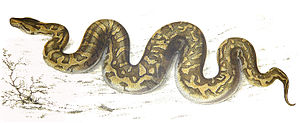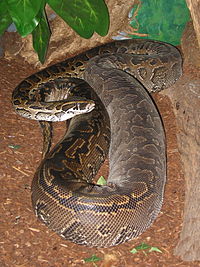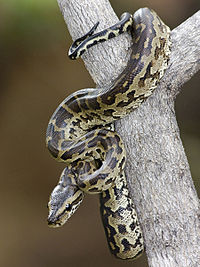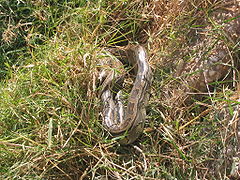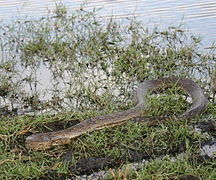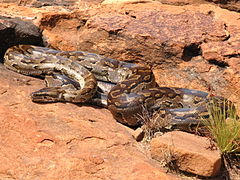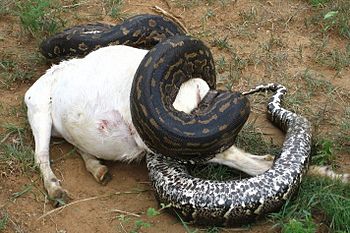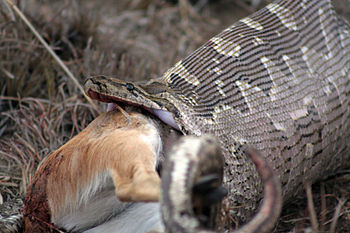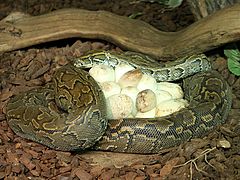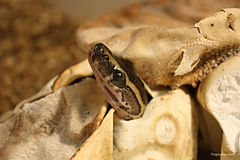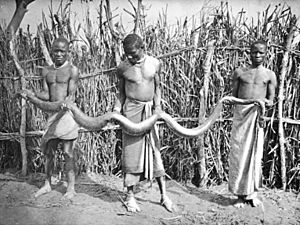- Python sebae
-
Python sebae 
An 18th-century illustration Scientific classification Kingdom: Animalia Phylum: Chordata Subphylum: Vertebrata Class: Reptilia Order: Squamata Suborder: Serpentes Family: Pythonidae Genus: Python Species: P. sebae Binomial name Python sebae
(Gmelin, 1788) Range of Python sebaeRange of Python natalensisInterference area of both species
Range of Python sebaeRange of Python natalensisInterference area of both speciesSynonyms Synonymy- Coluber Sebae – Gmelin, 1788
- C[oluber]. Speciosus – Bonnaterre, 1790
- Boa Hieroglyphica – Schneider, 1801
- Python Houttuyni – Daudin, 1803
- Python Liberiensis – Hallowell, 1845
- Hortulia Sebae – Gray, 1849
- Boa Liberiensis – Hallowell, 1854
- Python sebae – Boettger, 1887
- Python sebae – Boulenger, 1893
- Python jubalis – Pitman, 1936
- Python sebae sebae – Broadley, 1983
- Python sebae – Branch, 1991
- Python sebae – Kluge, 1993[1]
Python sebae (African rock python) is a large, non-venomous snake of Sub-Saharan Africa. The African rock python is one of seven species in the Python genus. It has two subspecies, one found in Central and Western Africa and the other in Southern Africa.
Africa's largest snake, specimens may approach or exceed 6 m (20 ft). The southern subspecies is generally smaller than its northern relative. The animal has a pattern of colored blotches on its body. It has dual lungs and vestigial limbs, which shows it is less advanced in evolution than other snakes.
The snake is found in a variety of habitats, from forests to near deserts, although usually near sources of water. The African rock python kills its prey by constriction and often eats animals up to the size of antelope, occasionally even crocodiles. The snake reproduces by egg-laying. Unlike most snakes, the female will protect her nest and sometimes even her hatchlings.
The snake is widely feared even though it only very rarely kills humans. Although the snake is not endangered, it does face threats from habitat reduction and hunting.
Contents
Taxonomy and etymology
The African rock python (Python sebae) is one of seven species of python, a genus of large constricting snakes found in the moist tropics of Asia and Africa. The African rock python is divided into two subspecies, Python sebae sebae (also often called the African rock python) and Python sebae natalis (the Southern African rock python).[2] Some consider the more southerly population of this snake to be a separate species, Python natalensis,[3][4] while others consider this form to be a subspecies.[5][6]
Python sebae was first described by Johann Friedrich Gmelin, a German naturalist, in 1788. He also first identified the sebae subspecies. The southern subspecies was first identified by Sir Andrew Smith, the father of South African zoology, in 1833.|[2][7]
Python is a Greek word referring to the enormous serpent at Delphi slain by Apollo in Greek Mythology. Sebae is a Latinization of Dutch zoologist, Albertus Seba.[7] Natalensis refers to the Natal region of South Africa. Common name usage varies with both the species and northern subspecies referred to as African rock python or simply rock python. The Southern African rock python is sometimes referred to as the Natal rock python.[7] African python.[8]
Subspecies Common name Scientific Name Classified by Year African rock python Python sebae sebae Gmelin 1788 Southern African rock python Python sebae natalensis Smith 1833 Description
Africa’s largest snake species[3][9] and one of the world's largest,[7] the typical African rock python adult measures 4.8 m (16 ft). Rumors of specimens over 6 m (20 ft) are considered reliable, although larger specimens have never been confirmed.[10] Males are typically smaller than females, with the largest one ever recorded measuring 4.4 m (14.5 ft) and weighing 62.6 kg (138 lb), caught in southern Florida. The snake varies considerably in body size between different areas. In general, it is smaller in highly populated regions, such as in southern Nigeria, only reaching its maximum length in areas such as Sierra Leone, where the human population density is lower.[11]
The African rock python's body is thick and covered with colored blotches, often joining up in a broad, irregular stripe. Body markings vary between brown, olive, chestnut, and yellow, but fade to white on the underside.[5][9] The head is triangular and is marked on top with a dark brown “spear-head” outlined in buffy yellow. Teeth are many, sharp, and backwardly curved.[4][9] Under the eye, there is a distinctive triangular marking, the subocular mark.[5] Like all pythons, the scales of the African rock python are small and smooth.[9][12] Those around the lips possess heat-sensitive pits, which are used to detect warm-blooded prey, even in the dark.[4][12][13] Pythons also possess two functioning lungs, unlike more advanced snakes which have only one, and also have small, visible pelvic spurs, believed to be the vestiges of hind limbs.[12][13]
The southern subspecies is distinguished by its smaller size (adults averaging about 2.4 to 4.4 meters in length), smaller scales on top of the head and a smaller or absent subocular mark.[3][5]
Adult female, northern subspecies. Note the thick body.Juvenile, southern subspecies. Note the small shields on top and the comparatively reduced markings on the side of the head.Head of northern subspecies. Note the big shields on top of the head.Range
The African rock python is found throughout almost the whole of sub-Saharan Africa,[14] from Senegal east to Ethiopia and Somalia and south to Namibia and South Africa.[6][9] Python sebae sebae ranges across central and western Africa, while Python sebae natalensis has a more eastern and southerly range, from southern Kenya to South Africa.[3]
In 2009, the African rock python was found in the Florida Everglades, and is feared to be establishing itself as an invasive species alongside the already-established Burmese Python.[15] Feral rock pythons were also noted in the 1990s in the Everglades.[10]
Habitat
The African rock python inhabits a wide range of habitats, including forest, savanna, grassland, semi-desert, and rocky areas. It is particularly associated with areas of permanent water[5][16] and is found on the edges of swamps, lakes and rivers,[3][9] The snake also readily adapts to disturbed habitats and so is often found around human habitation,[14] especially cane fields.[7]
Rock python habitats Northern subspecies, Senegal National ParkSouthern subspecies, edge of the Cuando River, BotswanaSouthern subspecies in the wildFeeding
Like all pythons, the African rock python is non-venomous and kills its prey by constriction.[4][13] After gripping the prey, the snake coils around it, tightening its coils every time the victim breathes out. Death is thought to be caused by cardiac arrest rather than by asphyxiation or crushing.[4] The African rock python feeds on a variety of large rodents, monkeys, warthog, antelopes, fruit bats, monitor lizards and even crocodiles in forest areas,[9] and on rats, poultry, dogs and goats in suburban areas.[17] A few cases are also known of this python hunting humans.[18]
Rock python feeding behavior Constricting a pregnant goatStretching to consume an antelopeReproduction
Reproduction occurs in the spring.[7] African rock pythons are oviparious, laying between 20 and 100 hard-shelled, elongated eggs in an old animal burrow, termite mound or cave.[3][9] The female shows a surprising level of maternal care, coiling around the eggs, protecting them from predators and possibly helping to incubate them, until they hatch around 90 days later.[3][4][9] It was recently discovered in a manner unusual for snakes in general and pythons in particular that the female guards the hatchlings for up to two weeks after they hatch from their eggs in order to protect them from predators.[19]
Hatchlings are between 45–60 cm (18-24 inches) in length and appear virtually identical to adults, except with more contrasting colors.[7] Individuals may live for over 12 years in captivity.[20]
Rock python egg development Brooding eggs Hatching Newborn Human interaction
Attacks on humans are very uncommon. Although this species can easily kill an adult, there are only a few cases in which the victim, in most cases a child, was actually consumed. A Ugandan newspaper reported in 1951 that a 13-year-old boy was swallowed, but the python was forced to disgorge the body. In 1973, another newspaper reported that a Portuguese soldier was discovered in the stomach of a snake. In 1979, a 14.9 ft (4.5 m) python killed a 13-year-old boy.[14] In Carlyle, Illinois in the summer of 1999 a 3-year-old boy was suffocated in his sleep by an escaped 7.5 ft specimen.[21] On Easter weekend of 2009, Ben Nyaumbe, a farmer, was attacked after stepping on a specimen and was dragged up a tree by the snake, but managed to escape after calling for help on his mobile phone.[22] The last known case in which a person was eaten occurred in South Africa in 2002, the victim being a 10-year-old child.[23]
People are often fearful of large pythons and may kill them on sight.[3][14] The African rock python may also be threatened by hunting for food and leather in some areas.[24] It is also collected for the pet trade, although it is not generally recommended as a pet due to its large size and unpredictable temperament.[20] Some of the African rock python’s habitats are also known to be under threat. For example, mangrove and rainforest habitats and their snake communities are under serious threat in south-eastern Nigeria from habitat destruction and exploration for the oil industry.[24][25] Little information is available on levels of international trade in this species.
The African rock python is still relatively common in many regions across Africa and may adapt to disturbed habitats,[14] provided that abundant food is available.[18] It is not currently considered at risk of extinction, but is listed on Appendix II of the Convention on International Trade in Endangered Species (CITES), meaning international trade in African rock pythons should be carefully monitored and controlled,[6] giving wild populations some protection from over-collection for pets and skins. The species is also likely to occur in a number of protected areas, such as the Serengeti National Park in Tanzania, a World Heritage Site.[26]
See also
- List of pythonid species and subspecies.
- Pythonidae by common name.
- Pythonidae by taxonomic synonyms.
References
This article incorporates text from the ARKive fact-file "Python sebae" under the Creative Commons Attribution-ShareAlike 3.0 Unported License and the GFDL.
- ^ McDiarmid RW, Campbell JA, Touré T. 1999. Snake Species of the World: A Taxonomic and Geographic Reference, vol. 1. Herpetologists' League. ISBN 1-893777-00-6 (series). ISBN 1-893777-01-4 (volume).
- ^ a b "Python sebae". Integrated Taxonomic Information System. http://www.itis.gov/servlet/SingleRpt/SingleRpt?search_topic=TSN&search_value=634785. Retrieved 12 September 2007.
- ^ a b c d e f g h O’Shea, M. (2007). Boas and Pythons of the World. London: New Holland Publishers. ISBN 1845375440. http://books.google.com/books?id=VDIbbpl_ktgC&printsec=frontcover.
- ^ a b c d e f Schmidt, W. (2006). Reptiles and Amphibians of Southern Africa. Cape Town, South Africa: Struik. ISBN 1770073426. http://books.google.com/books?id=D-T7qkR5K7QC&printsec=frontcover.
- ^ a b c d e Bartlett, P.P. and Wagner, E. (2009). Pythons. New York: Barron’s Educational Series. ISBN 0764142445. http://books.google.com/books?id=_Oov8-fxnWUC&printsec=frontcover.
- ^ a b c "CITES". CITES. http://www.cites.org/.
- ^ a b c d e f g Mehrtens JM. 1987. Living Snakes of the World in Color. New York: Sterling Publishers. ISBN 0-8069-6460-X.
- ^ Ditmars RL. 1933. Reptiles of the World. Revised Edition. The MacMillan Company.
- ^ a b c d e f g h i Alden, P.C., Estes, R.D., Schlitter, D. and McBridge, B (1996). Collins Guide to African Wildlife. London: HarperCollins Publishers.
- ^ a b Murphy JC, Henderson RW. 1997. Tales of Giant Snakes: A Historical Natural History of Anacondas and Pythons.Krieger Pub. Co. ISBN 0-89464-995-7.
- ^ Starin, E. D.; Burghardt, G. M. (1992). "African rock pythons (Python sebae) in the Gambia: observations on natural history and interactions with humans". The Snake 24: 50–62.
- ^ a b c Branch, B. and Branch, W.R. (1998). Field Guide to Snakes and Other Reptiles of Southern Africa. Cape Town, South Africa: Struik.
- ^ a b c Halliday, T. and Adler, K. (2002). The New Encyclopedia of Reptiles and Amphibians. Oxford: Oxford University Press. ISBN 0198525079.
- ^ a b c d e Branch, W.R. and Hacke, W.D. (1980). "A fatal attack on a young boy by an African rock python Python sebae". Journal of Herpetology 14 (3): 305–307. doi:10.2307/1563557. JSTOR 1563557.
- ^ David Fleshler (September 27, 2009). "Officials fear African python invading Florida's Everglades". Los Angeles Times. http://articles.latimes.com/2009/sep/27/nation/na-python27.
- ^ Luiselli, L., Akani, G.C., Eniang, E.A. and Politano, E. (2007) Comparative ecology and ecological modeling of sympatric pythons, Python regius and Python sebae. In: Henderson, R.W. and Powell, R. (Eds) Biology of the Boas and Pythons. EMP Press, Eagle Mountain, Utah.
- ^ Luiselli, L., Angelici, F.M. and Akani, G.C. (2001). "Food habits of Python sebae in suburban and natural habitats". African Journal of Ecology 39: 116–118. doi:10.1111/j.1365-2028.2001.00269.x.
- ^ a b Luiselli, L. (2009). Pers. comm.
- ^ Alexander, Graham; Johan Marais (2008). A Guide to the Reptiles of Southern Africa. Struik Publishers. pp. 408. ISBN 978-1770073869.
- ^ a b Bartlett, P.P., Griswold, B. and Bartlett, R.D. (2001). Reptiles, Amphibians, and Invertebrates: An Identification and Care Guide. New York: Barron’s Educational Series. ISBN 0764116509. http://books.google.com/books?id=Y8w0gEPC00AC&printsec=frontcover.
- ^ "AGN: Couple acquitted in child's death by python". Amarillo Globe-News. 25 March 2000. http://amarillo.com/stories/2000/03/25/usn_LA0687.shtml.
- ^ Man bites snake in epic struggle. BBC 15 April 2009. Accessed 15 April 2009.
- ^ Flanagan, Jane (November 25, 2002). "Children terrified as python eats boy". The Age. http://www.theage.com.au/articles/2002/11/24/1037697985131.html. Retrieved January 14, 2010.
- ^ a b Luiselli, L. and Akani, G.C. (2002). "An investigation into the composition, complexity and functioning of snake communities in the mangroves of south-eastern Nigeria". African Journal of Ecology 40 (3): 220–227. doi:10.1046/j.1365-2028.2002.00358.x.
- ^ Akani, G.C., Barieenee, I.F., Capizzi, D. and Luiselli, L. (1999). "Snake communities of moist rainforest and derived savanna sites of Nigeria: biodiversity patterns and conservation priorities". Biodiversity and Conservation 8 (5): 629–642. doi:10.1023/A:1008849702810.
- ^ "Serengeti National Park, Tanzania". UNEP-WCMC. http://www.unep-wcmc.org/sites/wh/pdf/Serengeti.pdf.
External links
- Python sebae media at ARKive
- Python sebae at the Reptarium.cz Reptile Database. Accessed 12 September 2007.
Categories:- Pythonidae
- Reptiles of Africa
Wikimedia Foundation. 2010.

